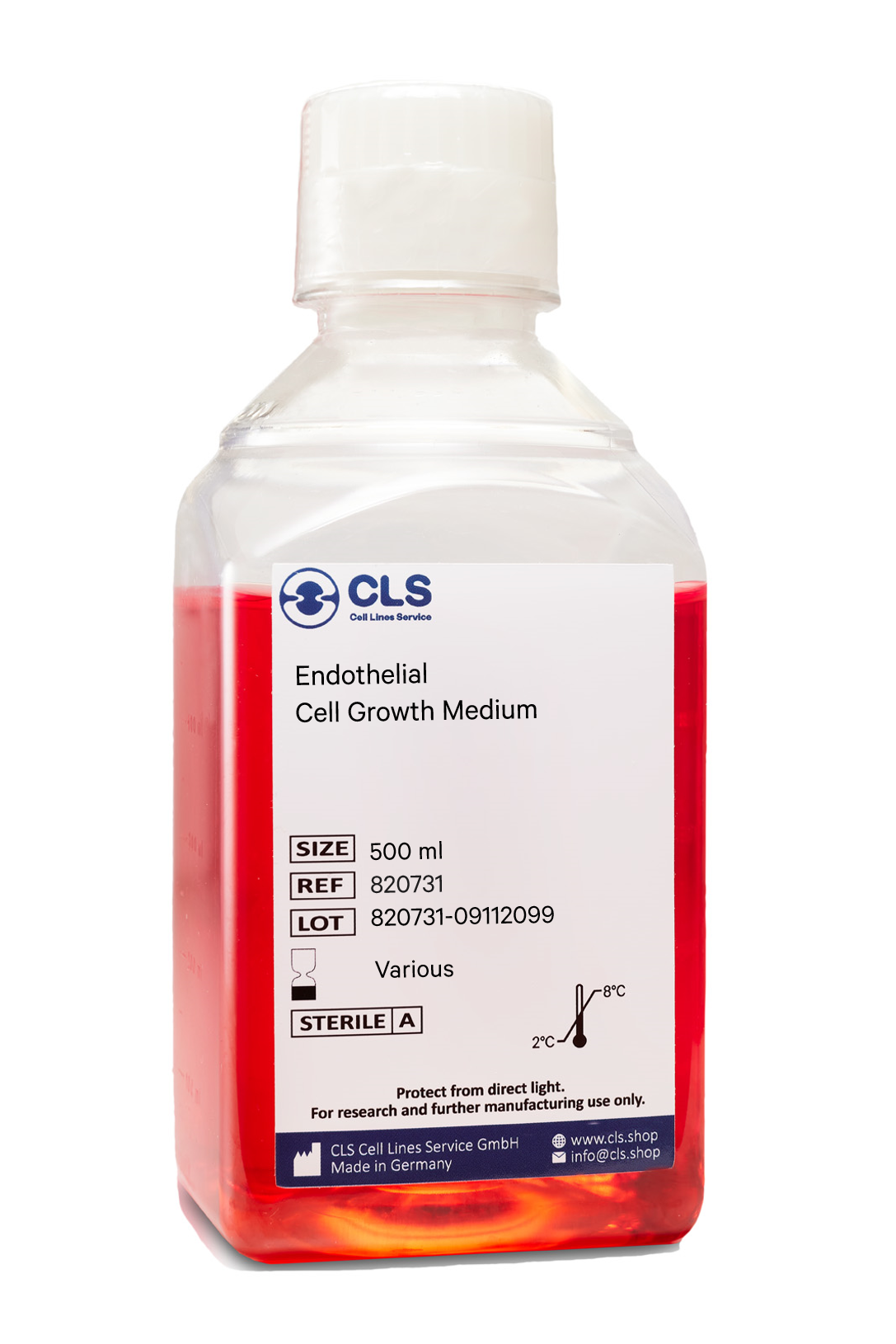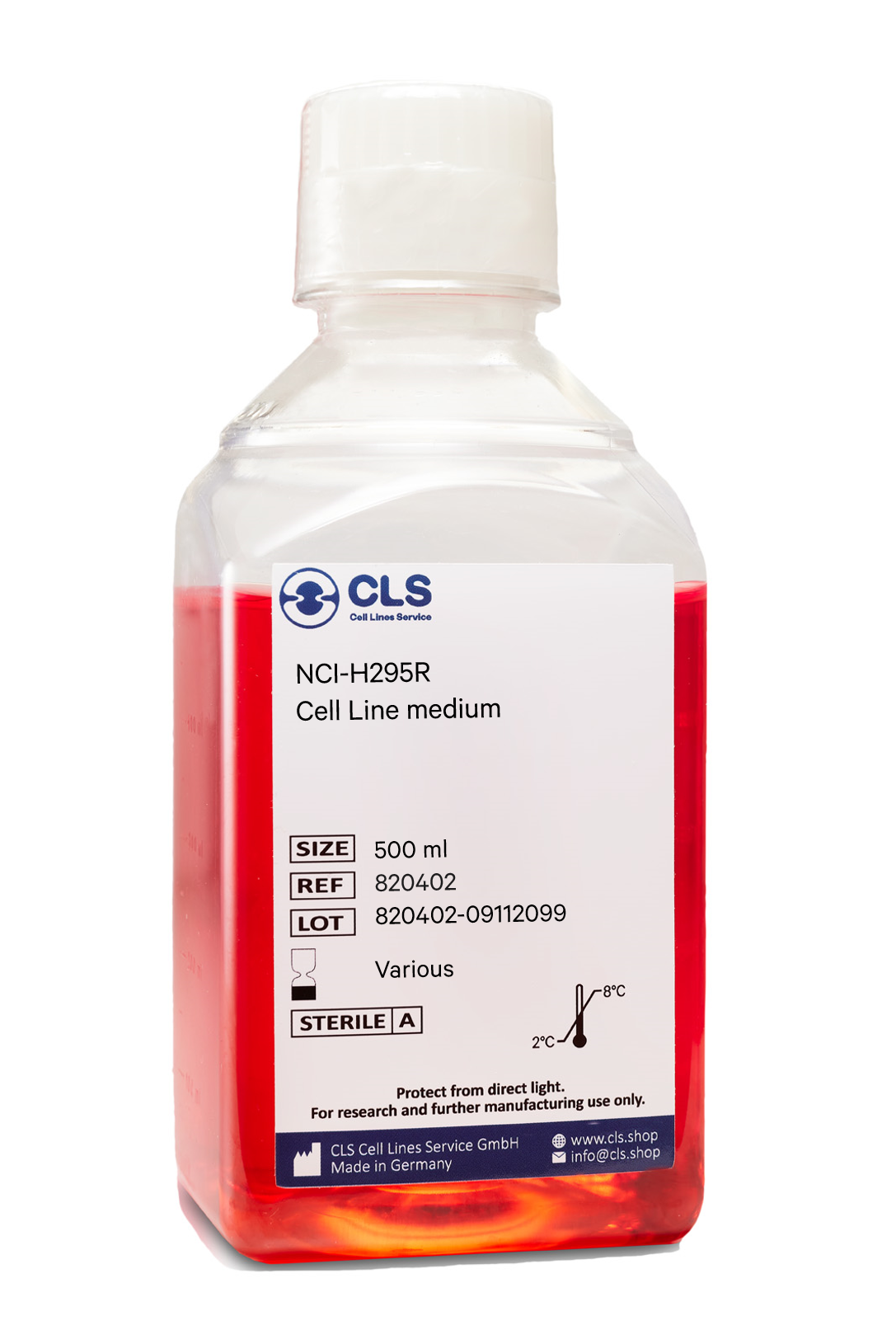Filter
–
Endothelial Cell Growth Medium
€140.00*
Endothelial cells play a crucial role in the circulatory system by transporting nutrients and waste throughout the body. Researchers and scientists need a medium that can sustain the development and maintenance of endothelial cells in vitro so that they may study their function and malfunction. CLS Endothelial Cell Growth Medium fills this need by creating an environment where endothelial cells may thrive throughout their growth and maintenance phases.
Definition of Endothelial Cell Growth Media
An in-vitro cell culture system requires a particular solution called Endothelial Cell Growth Media to sustain the endothelial cells necessary for the experiment. Endothelial cells in the body are exposed to an environment mimicked by the medium, including necessary and non-essential amino acids, vitamins, hormones, growth factors, and trace minerals. This nutrient-dense fluid is critical for preserving the endothelium phenotype and function because it stimulates cell proliferation. Globally, researchers and scientists rely on the CLS Endothelial Cell Growth Medium because it is both effective and simple.
Importance of Endothelial Cell Research
Blood artery creation, blood pressure control, and wound healing are just a few physiological processes in which endothelial cells play a key part. To keep the blood vessels balanced, these cells may react to chemical and mechanical stimuli. In order to fully comprehend the causes of hypertension, atherosclerosis, and thrombosis, research into endothelial cells is crucial. Investigating endothelial cells may also provide light on how to treat these diseases medically. Providing a stable and uniform environment for endothelial cell development and proliferation, the CLS Endothelial Cell Growth Medium has shown to be an indispensable tool in this kind of study.
Quality Assurance
High-quality in-vitro cell culture media is essential for obtaining consistent and repeatable outcomes. Quality control testing is performed on every CLS Endothelial Cell Growth Media batch to guarantee its uniformity and effectiveness. The sterility, lack of mycoplasma and bacteria, and pH levels of each batch are examined. To promote healthy cell development and proliferation, the medium's pH is kept at 7.2 +/
- 0.02, and the temperature is maintained between 20 and 25 degrees Celsius. To ensure the culture is clear of any contamination that might impact the accuracy of the findings, the medium is also checked for microbiological pollutants such as fungus, bacteria, and mycoplasma.
Maintenance and Disclaimer
The expiration date of CLS Endothelial Cell Growth Media is six weeks from the production date. The medium should be kept at a temperature of between +2°C and +8°C, away from light, and never frozen or heated over 37°C to preserve its quality. As a corollary, it is crucial to avoid microwaves and other unregulated heat sources that might compromise the product's integrity. A portion of the medium may be taken out of the container and brought up to room temperature if just a little amount will be utilized. CLS's Endothelial Cell Growth Medium is a tried and true method for cultivating endothelial cells because of the stringent quality controls used in its production.
Notably, the CLS Endothelial Cell Growth Medium is not for clinical or diagnostic use; it is designed primarily for in-vitro usage. Obtaining accurate and reliable findings from the medium requires strict adherence to the manufacturer's guidelines and quality control methods.
Applications of the Medium
The CLS Endothelial Cell Growth Medium has proven useful in several biological studies. As this medium may be used to cultivate endothelial cells, it can be used to simulate endothelial function and malfunction in organ systems in vitro. This is especially useful for studying the blood-brain barrier or tissue-engineered blood arteries. This is essential for understanding disease processes and creating effective treatments.
Endothelial cells, especially HUVEC cells, have been extensively employed in angiogenesis research, wound healing research, and cancer research, thus, the medium has also been modified to promote their proliferation. Accurate and repeatable findings depend on the consistency and high quality of the medium used to develop these cells, and the CLS Endothelial Cell Growth Media meets both of these requirements.
Definition of Endothelial Cell Growth Media
An in-vitro cell culture system requires a particular solution called Endothelial Cell Growth Media to sustain the endothelial cells necessary for the experiment. Endothelial cells in the body are exposed to an environment mimicked by the medium, including necessary and non-essential amino acids, vitamins, hormones, growth factors, and trace minerals. This nutrient-dense fluid is critical for preserving the endothelium phenotype and function because it stimulates cell proliferation. Globally, researchers and scientists rely on the CLS Endothelial Cell Growth Medium because it is both effective and simple.
Importance of Endothelial Cell Research
Blood artery creation, blood pressure control, and wound healing are just a few physiological processes in which endothelial cells play a key part. To keep the blood vessels balanced, these cells may react to chemical and mechanical stimuli. In order to fully comprehend the causes of hypertension, atherosclerosis, and thrombosis, research into endothelial cells is crucial. Investigating endothelial cells may also provide light on how to treat these diseases medically. Providing a stable and uniform environment for endothelial cell development and proliferation, the CLS Endothelial Cell Growth Medium has shown to be an indispensable tool in this kind of study.
Quality Assurance
High-quality in-vitro cell culture media is essential for obtaining consistent and repeatable outcomes. Quality control testing is performed on every CLS Endothelial Cell Growth Media batch to guarantee its uniformity and effectiveness. The sterility, lack of mycoplasma and bacteria, and pH levels of each batch are examined. To promote healthy cell development and proliferation, the medium's pH is kept at 7.2 +/
- 0.02, and the temperature is maintained between 20 and 25 degrees Celsius. To ensure the culture is clear of any contamination that might impact the accuracy of the findings, the medium is also checked for microbiological pollutants such as fungus, bacteria, and mycoplasma.
Maintenance and Disclaimer
The expiration date of CLS Endothelial Cell Growth Media is six weeks from the production date. The medium should be kept at a temperature of between +2°C and +8°C, away from light, and never frozen or heated over 37°C to preserve its quality. As a corollary, it is crucial to avoid microwaves and other unregulated heat sources that might compromise the product's integrity. A portion of the medium may be taken out of the container and brought up to room temperature if just a little amount will be utilized. CLS's Endothelial Cell Growth Medium is a tried and true method for cultivating endothelial cells because of the stringent quality controls used in its production.
Notably, the CLS Endothelial Cell Growth Medium is not for clinical or diagnostic use; it is designed primarily for in-vitro usage. Obtaining accurate and reliable findings from the medium requires strict adherence to the manufacturer's guidelines and quality control methods.
Applications of the Medium
The CLS Endothelial Cell Growth Medium has proven useful in several biological studies. As this medium may be used to cultivate endothelial cells, it can be used to simulate endothelial function and malfunction in organ systems in vitro. This is especially useful for studying the blood-brain barrier or tissue-engineered blood arteries. This is essential for understanding disease processes and creating effective treatments.
Endothelial cells, especially HUVEC cells, have been extensively employed in angiogenesis research, wound healing research, and cancer research, thus, the medium has also been modified to promote their proliferation. Accurate and repeatable findings depend on the consistency and high quality of the medium used to develop these cells, and the CLS Endothelial Cell Growth Media meets both of these requirements.
NCI-H295R Cell Growth Medium
€150.00*
NCI-H295R Cell Growth Medium
Discover the advanced NCI-H295R Cell Growth Medium, an expertly crafted nutrient solution specifically designed to foster the growth and maintenance of mammalian cell lines, including the specialized NCI-H295R cells. This medium stands out with its unique blend of Dulbecco's Modified Eagle Medium (DMEM) and Ham's F-12 (Nutrient Mixture F-12) in a precise 1:1 ratio, enriched with essential supplements to meet the intricate needs of cell culture.
Enhanced Formulation for Superior Cell Culture Performance
Supplemented Baseline: The basic medium is already rich, combining DMEM's high amino acid and vitamin concentrations with the diverse nutrients of Ham's F-12. To this potent mix, we've added 5% Fetal Bovine Serum (FBS), providing crucial growth factors, hormones, and proteins.
Tailored Additives: Beyond FBS, this medium is fortified with critical supplements including Insulin, Transferrin, Bovine Serum Albumin, Selenious Acid, and Lineloic Acid. These additions cater to specific cellular requirements, promoting enhanced cell growth, metabolic function, and overall health.
L-Glutamine Boost: The presence of L-glutamine further amplifies the medium's efficacy, supporting essential metabolic processes and encouraging robust cell proliferation.
Optimized for Cell Culture
pH Controlled Environment: Incorporating a bicarbonate buffer system and phenol red indicator, the medium ensures a stable pH environment. It is optimized for a 5% CO2 atmosphere, allowing for precise pH monitoring and adjustment.
Quality and Purity: Each lot of basic medium undergoes rigorous testing for sterility, mycoplasma, and bacteria, ensuring the medium's integrity. With a pH maintained medium, you can trust in the consistent quality and performance of this medium.
Handling and Storage
Maintain the medium's quality by storing it refrigerated at +2°C to +8°C, away from light. Avoid extremes, such as freezing or overheating, to preserve its efficacy. For partial use, gently warm the needed quantity at room temperature, ensuring the medium is brought to the appropriate condition without compromising its components.
Shelf life
With an 8-week shelf life from the manufacturing date, the NCI-H295R Cell Growth Medium is a reliable choice for your cell culture needs, ensuring the vitality and productivity of your research.
Discover the advanced NCI-H295R Cell Growth Medium, an expertly crafted nutrient solution specifically designed to foster the growth and maintenance of mammalian cell lines, including the specialized NCI-H295R cells. This medium stands out with its unique blend of Dulbecco's Modified Eagle Medium (DMEM) and Ham's F-12 (Nutrient Mixture F-12) in a precise 1:1 ratio, enriched with essential supplements to meet the intricate needs of cell culture.
Enhanced Formulation for Superior Cell Culture Performance
Supplemented Baseline: The basic medium is already rich, combining DMEM's high amino acid and vitamin concentrations with the diverse nutrients of Ham's F-12. To this potent mix, we've added 5% Fetal Bovine Serum (FBS), providing crucial growth factors, hormones, and proteins.
Tailored Additives: Beyond FBS, this medium is fortified with critical supplements including Insulin, Transferrin, Bovine Serum Albumin, Selenious Acid, and Lineloic Acid. These additions cater to specific cellular requirements, promoting enhanced cell growth, metabolic function, and overall health.
L-Glutamine Boost: The presence of L-glutamine further amplifies the medium's efficacy, supporting essential metabolic processes and encouraging robust cell proliferation.
Optimized for Cell Culture
pH Controlled Environment: Incorporating a bicarbonate buffer system and phenol red indicator, the medium ensures a stable pH environment. It is optimized for a 5% CO2 atmosphere, allowing for precise pH monitoring and adjustment.
Quality and Purity: Each lot of basic medium undergoes rigorous testing for sterility, mycoplasma, and bacteria, ensuring the medium's integrity. With a pH maintained medium, you can trust in the consistent quality and performance of this medium.
Handling and Storage
Maintain the medium's quality by storing it refrigerated at +2°C to +8°C, away from light. Avoid extremes, such as freezing or overheating, to preserve its efficacy. For partial use, gently warm the needed quantity at room temperature, ensuring the medium is brought to the appropriate condition without compromising its components.
Shelf life
With an 8-week shelf life from the manufacturing date, the NCI-H295R Cell Growth Medium is a reliable choice for your cell culture needs, ensuring the vitality and productivity of your research.


